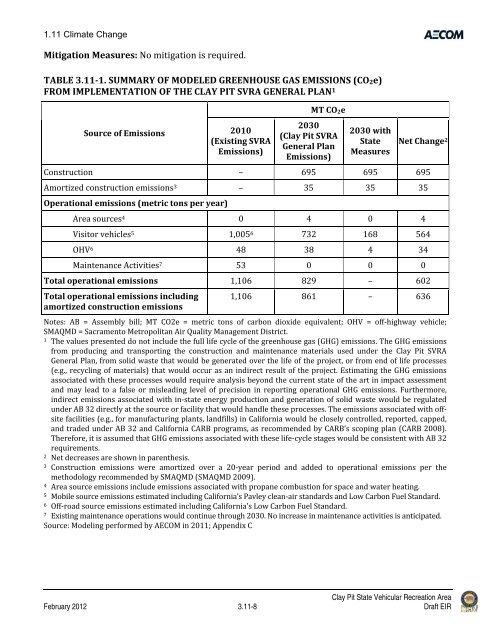Draft Environmental Impact Report - California Off Highway Vehicle ...
Draft Environmental Impact Report - California Off Highway Vehicle ...
Draft Environmental Impact Report - California Off Highway Vehicle ...
Create successful ePaper yourself
Turn your PDF publications into a flip-book with our unique Google optimized e-Paper software.
1.11 Climate Change<br />
Mitigation Measures: No mitigation is required.<br />
TABLE 3.111. SUMMARY OF MODELED GREENHOUSE GAS EMISSIONS (CO2e)<br />
FROM IMPLEMENTATION OF THE CLAY PIT SVRA GENERAL PLAN 1<br />
Source of Emissions<br />
2010<br />
(Existing SVRA<br />
Emissions)<br />
MT CO2e<br />
2030<br />
(Clay Pit SVRA<br />
General Plan<br />
Emissions)<br />
2030 with<br />
State<br />
Measures<br />
Net Change 2<br />
Construction – 695 695 695<br />
Amortized construction emissions 3 – 35 35 35<br />
Operational emissions (metric tons per year)<br />
Area sources 4 0 4 0 4<br />
Visitor vehicles 5 1,005 6 732 168 564<br />
OHV 6 48 38 4 34<br />
Maintenance Activities 7 53 0 0 0<br />
Total operational emissions 1,106 829 – 602<br />
Total operational emissions including<br />
amortized construction emissions<br />
1,106 861 – 636<br />
Notes: AB = Assembly bill; MT CO2e = metric tons of carbon dioxide equivalent; OHV = off‐highway vehicle;<br />
SMAQMD = Sacramento Metropolitan Air Quality Management District.<br />
1 The values presented do not include the full life cycle of the greenhouse gas (GHG) emissions. The GHG emissions<br />
from producing and transporting the construction and maintenance materials used under the Clay Pit SVRA<br />
General Plan, from solid waste that would be generated over the life of the project, or from end of life processes<br />
(e.g., recycling of materials) that would occur as an indirect result of the project. Estimating the GHG emissions<br />
associated with these processes would require analysis beyond the current state of the art in impact assessment<br />
and may lead to a false or misleading level of precision in reporting operational GHG emissions. Furthermore,<br />
indirect emissions associated with in‐state energy production and generation of solid waste would be regulated<br />
under AB 32 directly at the source or facility that would handle these processes. The emissions associated with off‐<br />
site facilities (e.g., for manufacturing plants, landfills) in <strong>California</strong> would be closely controlled, reported, capped,<br />
and traded under AB 32 and <strong>California</strong> CARB programs, as recommended by CARB’s scoping plan (CARB 2008).<br />
Therefore, it is assumed that GHG emissions associated with these life‐cycle stages would be consistent with AB 32<br />
requirements.<br />
2 Net decreases are shown in parenthesis.<br />
3 Construction emissions were amortized over a 20‐year period and added to operational emissions per the<br />
methodology recommended by SMAQMD (SMAQMD 2009).<br />
4 Area source emissions include emissions associated with propane combustion for space and water heating.<br />
5 Mobile source emissions estimated including <strong>California</strong>’s Pavley clean‐air standards and Low Carbon Fuel Standard.<br />
6 <strong>Off</strong>‐road source emissions estimated including <strong>California</strong>’s Low Carbon Fuel Standard.<br />
7 Existing maintenance operations would continue through 2030. No increase in maintenance activities is anticipated.<br />
Source: Modeling performed by AECOM in 2011; Appendix C<br />
Clay Pit State Vehicular Recreation Area<br />
February 2012 3.11-8 <strong>Draft</strong> EIR








